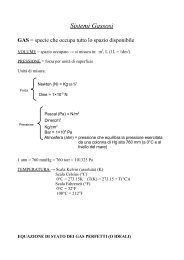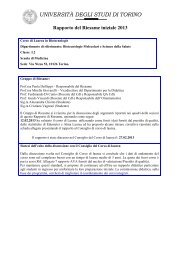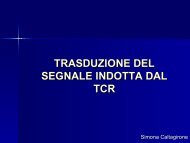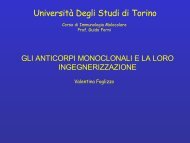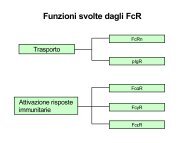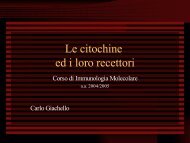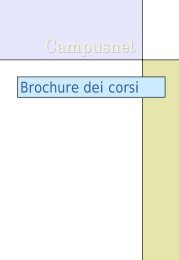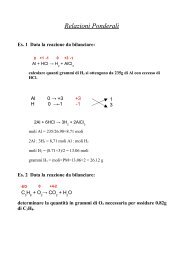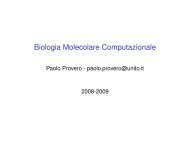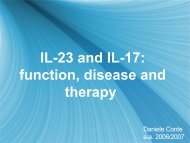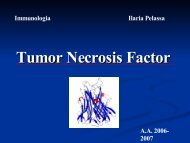Processi che coinvolgono la chemochine e i loro recettori
Processi che coinvolgono la chemochine e i loro recettori
Processi che coinvolgono la chemochine e i loro recettori
You also want an ePaper? Increase the reach of your titles
YUMPU automatically turns print PDFs into web optimized ePapers that Google loves.
<strong>Processi</strong> <strong>che</strong> <strong>coinvolgono</strong><br />
<strong>la</strong> <strong>che</strong>mochine e i <strong>loro</strong><br />
<strong>recettori</strong><br />
Annarita Zeoli
Sviluppo nei tessuti<br />
linfoidi primari<br />
Migrazione linfocitaria<br />
Homing linfocitario<br />
Timo<br />
CXCR4/CXCL12<br />
CCR9/ CCL25<br />
CCR4/ CCL17/CCL22<br />
CCR7/ CCL19/CC21<br />
LN, milza, PP<br />
CXCR5/CXCL13<br />
CCR7/CCL19/CCL21<br />
CCR4/CCL22<br />
LN/Milza<br />
CCR7/CCL19/CCL21<br />
CXCR4/CXCL12<br />
Ag<br />
Derma<br />
CCR4/CCL17<br />
CCR10/CCL27<br />
PP<br />
CCR7/CCL19/CCL21<br />
CXCR4/CXCL12<br />
CXCR5/CXCL13<br />
Midollo osseo<br />
CXCR4/CXCL12<br />
CCR9/CCL25<br />
Intestino<br />
CCR9/CCL25<br />
CCR10/CCL28<br />
D.J. Campbell et al., Chemochine in the systemic organization of immunity,Immunological Reviews,195: 58-71,2003
Chemochine omeostati<strong>che</strong>:<br />
Sono prodotte in tessuti linfoidi e non linfoidi e<br />
sono coinvolte nel mantenimento fisiologico del<br />
traffico e dell’ homing cellu<strong>la</strong>re<br />
Chemochine infiammatorie:<br />
Sono espresse in tessuti infiammati in seguito a<br />
stimo<strong>la</strong>zione di citochine pro-infiammatorie o<br />
in seguito al contatto con agenti patogeni; sono<br />
coinvolte nel reclutamento di cellule effettrici<br />
come i monociti, granulociti e cellule T<br />
effettrici
CXCL12 e CXCR4 mediano <strong>la</strong> localizzazione e l’homing delle HSC<br />
HSC (cellule staminali ematopoieti<strong>che</strong>)<br />
CXCR4<br />
CXCL12<br />
Midollo<br />
Sangue<br />
Matrice ossea
Sviluppo dei linfociti T nel timo<br />
timocita<br />
capsu<strong>la</strong><br />
corteccia<br />
protimocita<br />
CXCL12+<br />
CCL25 -<br />
CCR9 -<br />
CXCR4+<br />
CCR9+<br />
CCR9+<br />
CCR9+<br />
CCL25+<br />
Cellule<br />
epiteliali<br />
corticali<br />
macrofagi<br />
midol<strong>la</strong>re<br />
CCR4 +<br />
CCL22 +<br />
T maturi naive<br />
CCR7+<br />
CCR4 -<br />
Cellule<br />
dendriti<strong>che</strong><br />
Cellule<br />
epiteliali<br />
midol<strong>la</strong>ri
Sviluppo dei linfociti B<br />
SDF-1<br />
CCL25<br />
CXCR4<br />
CCR9<br />
CCR7<br />
MIDOLLO OSSEO<br />
SANGUE<br />
HSC<br />
cellu<strong>la</strong> Pro-B<br />
Cellu<strong>la</strong> pre-B<br />
B maturo<br />
CXCR4+/<br />
CXCL12+ CCR9+/CCL25+<br />
CXCR4+/CXCL12+<br />
CXCR4+/CXCL12+<br />
CCR9+/CCL25+<br />
CCR7+<br />
CXCR4 -
Homing dei linfociti nel<strong>la</strong> milza, nelle p<strong>la</strong>c<strong>che</strong> di Peyer (PP) e<br />
nel linfonodo (LN)<br />
Homing cellule B<br />
naive(CCR7/CXCR4+)<br />
Homing cellule T naive (CCR7+)<br />
CXCR5/CXCL13<br />
(mediano <strong>la</strong> localizzazione follico<strong>la</strong>re<br />
nel<strong>la</strong> milza, PP e nel<strong>la</strong> regione FDC+<br />
del LN)<br />
CCL21 ( HEV) PP<br />
CCL19 (DCs) LN<br />
CCR6 ( media <strong>la</strong><br />
localizzazione nel<strong>la</strong><br />
regione FDC- )<br />
Rie<strong>la</strong>borata da Federica Collino
MIP-1α<br />
MIP-1β<br />
RANTES<br />
CCR1/CCR5<br />
CCR4<br />
CXCR4<br />
CCR7<br />
ELC<br />
TARC<br />
MDC<br />
DC-CK1<br />
Vaso afferente<br />
TNF-α<br />
IFN-γ<br />
LINFONODO<br />
<br />
DC<br />
CXCR1/CCR1/<br />
CCR2/CCR5<br />
follicolo<br />
midol<strong>la</strong>re<br />
vena<br />
arteria<br />
Vaso efferente<br />
corteccia
ZONA T (FDC-)<br />
ZONA B (FDC+)<br />
HEV<br />
T naive<br />
CXCR4+<br />
CCR7+<br />
B<br />
CCR7+<br />
CXCR5+<br />
CXCR4+<br />
DC<br />
CCR7+<br />
CCL22+<br />
CXCL16+<br />
CCR7+<br />
CXCR6+<br />
CCR4+<br />
CXCR4+<br />
T memoria<br />
T CD4+<br />
CXCR5<br />
CCR7+<br />
CXCR4+<br />
CCR4+<br />
Tfh<br />
CXCR5+<br />
CCR4+<br />
CXCR4+<br />
B<br />
CCR7<br />
CCL22+<br />
Tfh<br />
CXCR4+<br />
CXCR5+<br />
TCD4m<br />
CCR1+<br />
CCR4+<br />
CCR6+<br />
CCR7+<br />
CXCR4+<br />
Tem<br />
Tem<br />
CCR1+<br />
attivati<br />
CXCR5+ CCR3+<br />
CCR4+<br />
CCR5+<br />
CCR7+<br />
CCR6+<br />
CCR8+<br />
CXCR3+<br />
T effettore<br />
CD8+<br />
CXCR5<br />
CCR7<br />
BCA-1<br />
SLC,ECL<br />
p<strong>la</strong>smacellule B memoria<br />
CXCR5+<br />
CCR7+
Differenziazione Th1 e Th2<br />
Patogeni intracellu<strong>la</strong>ri<br />
CCL3+<br />
CCL4+<br />
CCL5+<br />
Th1<br />
CCR5+<br />
CXCR3+<br />
CCR7<br />
produzione IFN-γ<br />
IP-10<br />
Mig<br />
MIP-1β<br />
T helper<br />
CCL2+<br />
Altri meccanismi<br />
MDC<br />
TARC<br />
TCA-3<br />
Patogeni extracellu<strong>la</strong>ri<br />
Th2<br />
CCR4+<br />
CCR8+<br />
CCR2+<br />
CCR7<br />
produzione<br />
IL-4 e IL-13<br />
S.A. Luther et al., Chemokine as regu<strong>la</strong>tors of T cell differentiation, Nature immunology, 2: 102-107,2001
CCL3,4,5<br />
APC<br />
Th<br />
Th1<br />
CCR5<br />
CCR2<br />
APC<br />
CCL2<br />
APC<br />
Th<br />
Th2<br />
Attivazione<br />
CCL3,4,5<br />
Th1<br />
APC<br />
Th<br />
Th<br />
CCL2<br />
S.A. Luther et al., Chemokine as regu<strong>la</strong>tors of T cell differentiation, Nature immunology, 2: 102-107,2001<br />
Th2
Homing linfocitario tessuto specifico<br />
CCR9<br />
Intestino tenue<br />
microvilli<br />
vena<br />
arteria<br />
cripta<br />
IgA<br />
CXCR4<br />
α4β7<br />
α4β1<br />
α4β1<br />
CCR9<br />
T<br />
CXCR4<br />
CCL25<br />
MADCAM1
Cellule epiteliali<br />
CCR10<br />
IgA<br />
CXCR4<br />
α4β7<br />
α4β1<br />
<br />
α4β1<br />
T<br />
CCL28<br />
CXCR4<br />
Epidermide<br />
CCL27<br />
CCL17<br />
CCR10<br />
α4β1<br />
T<br />
CCR4<br />
CXCR4<br />
CLA
Midollo osseo e tessuti infiammati<br />
CCR10<br />
IgA<br />
α4β1<br />
CXCR4<br />
α4β7<br />
CXCR3<br />
CXCL12<br />
IgG<br />
α4β1<br />
CCL9<br />
CXCR4<br />
CCL10<br />
CXCR3<br />
IgG<br />
α4β1<br />
CXCR4
Recettori per le <strong>che</strong>mochine come target terapeutici<br />
AIDS<br />
Cancro<br />
CXCR4<br />
CXCR5<br />
CXCR6<br />
XCR1<br />
CX3CR1<br />
costitutivi<br />
CCR8<br />
CCR6<br />
Asma<br />
CCR10<br />
CCR11<br />
inducibili<br />
CXCR1<br />
CXCR2<br />
Arteriosclerosi<br />
MS<br />
Trapianti<br />
RA<br />
Asma<br />
Nefrite<br />
AIDS<br />
CCR7<br />
CCR5<br />
CCR4<br />
Asma<br />
CCR3<br />
CCR2<br />
CCR1<br />
CXCR3<br />
MS<br />
RA<br />
Asma<br />
Arteriosclerosi<br />
MS<br />
RA<br />
Trapianti<br />
MS<br />
Trapianti<br />
RA<br />
Asma<br />
Nefrite<br />
A.E.I. Proudfoot, Chemokine receptors: a multifaceted therapeutic targets, Nature rew. Immunology,2: 106-115,2002
Sclerosi multip<strong>la</strong><br />
Cellule T<br />
attivate<br />
Monociti<br />
CCR1<br />
CCR1<br />
CCR5<br />
CCR5<br />
CXCR3<br />
CCL4<br />
CCR5<br />
CXCR3<br />
CCR1<br />
CCL9<br />
CXCL10<br />
Cervello<br />
CXCL11<br />
CCR5<br />
CCR1<br />
CCL3<br />
CCL5<br />
A.E.I. Proudfoot, Chemokine receptors: a multifaceted therapeutic targets, Nature rew. Immunology,2: 106-115,2002
Infezione del virus HIV<br />
gp120<br />
CD4<br />
CCR5<br />
gp41<br />
CD4<br />
La mutazione Δ32-CCR5 impedisce<br />
l’espressione di un recettore funzionale<br />
e, di conseguenza, il legame del virus,<br />
<strong>la</strong> fusione con <strong>la</strong> cellu<strong>la</strong> ospite e infine<br />
l’infezione<br />
Δ32-CCR5<br />
A.E.I. Proudfoot, Chemokine receptors: a multifaceted therapeutic targets, Nature rew.<br />
Immunology,2: 106-115,2002
Antagonisti dei <strong>recettori</strong> per le <strong>che</strong>mochine<br />
Anticorpi :<br />
Ab anti-CXCR3 ( trattamento del rigetto dopo trapianto di cuore)<br />
Ab anti-CXCR4 ( prevenzione metastasi)<br />
Chemochine modificate (delezione N-terminale):<br />
(9-68)-CCL2 ( riduzione sintomi infiammatori in topi MRL-Ipr con artrite spontanea)<br />
Met-CCL5 blocca CCR1 e CCR5 nelle infiammazioni Th1( nefriti, coliti….),<br />
CCR3 nelle infiammazioni Th2<br />
Piccole molecole:<br />
TAK779 inibitore di CCR5 e CCR2<br />
BX471 inibitore selettivo per CCR1
BIBLIOGRAFIA<br />
D. J. Campbell et al, Chemokines in the systemic organization of immunity,<br />
Immunological Reviews, 195: 58-71, 2003<br />
S. A. Luther et al, Chemokines as regu<strong>la</strong>tors of T cell differentiation, Nature<br />
immunology, 2: 102-107, 2001<br />
C. R. Mackay, Chemokines: immunology’s high impact factors, Nature<br />
immunology, 2: 95-101, 2001<br />
B. Moser, P. Loets<strong>che</strong>r, Lymphocyte traffic control by <strong>che</strong>mokines, Nature<br />
immunology, 2: 123-128, 2001<br />
T. S. Olson, K. Ley, Chemokines and <strong>che</strong>mokine receptors in leukocyte trafficking,<br />
Am J Physiol Regu<strong>la</strong>tory Integrative Comp Physiol, 283: 7-28, 2002<br />
B. Moser et al, Chemokines: multiple levels of leukocyte migration control, Trends<br />
in immunology, 25: 75-84, 2004<br />
P. J. Nelson et al, Chemokines, <strong>che</strong>mokine receptors and allograft rejection,<br />
Immunity, 14: 377-386, 2001<br />
A. Zlotnik et al, Chemokines: a new c<strong>la</strong>ssification system and their role in immunity,<br />
Immunity, 12: 121-127, 2000<br />
A. E. I. Proudfoot, Chemokine receptors: multifaceted therapeutic targets, Nature<br />
Reviews Immunology, 2: 106-115, 2002<br />
E. J. Kunkel et al, P<strong>la</strong>sma-cell homing, Nature Reviews Immunology, 3: 822-829,<br />
2003<br />
M. Thelen, Dancing to the tune of <strong>che</strong>mokines, Nature immunology, 2: 129-134,



